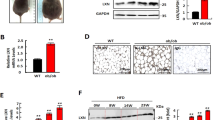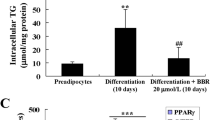Abstract
Objective:
Evodiamine (evo) has been shown to exert anti-inflammatory, antinociceptive and anticancer effects. In this study, we investigated the effects of evo alone and in combination with rosiglitazone (rosi) on in vitro adipocyte differentiation and in vivo obesity related to diabetes.
Methods:
Adipocyte differentiation was investigated in vitro using 3T3-L1 and C3H10T1/2 cells. To determine the degree of differentiation, Oil Red O staining and reverse transcription–PCR were carried out. Four groups of db/db mice were treated intraperitoneally once per day with vehicle, evo, rosi and evo+rosi. The mice were killed after 14 days and the blood, liver and adipose tissue were analyzed.
Results:
The presence of evo or evo combined with rosi during adipogenic induction has been shown to inhibit adipocyte differentiation to a significant degree, particularly at the commitment and early induction stages. The evo and evo+rosi groups of db/db mice evidenced significant reductions in body weight gain. The ratio of epididymal white adipocyte tissue weight to body weight of the evo group was also significantly reduced. It is important to note that in the evo+rosi treatment, blood glucose levels were reduced to a degree similar to that of the rosi group, and plasma insulin levels were reduced significantly better than that of rosi group. Furthermore, hepatic lesions associated with fat and glycogen deposition were morphologically improved in the evo and evo+rosi groups.
Conclusion:
The results of this study showed that evo exerts an inhibitory effect on in vitro adipocyte differentiation and in vivo obesity, and also an improvement effect on insulin resistance. These desirable effects of evo were noted even in the presence of rosi. These results indicate that evo improves the undesirable effects of rosi, including adipogenesis, body weight gain and hepatotoxicity, while preserving its desirable blood-glucose-lowering effect.
This is a preview of subscription content, access via your institution
Access options
Subscribe to this journal
Receive 12 print issues and online access
$259.00 per year
only $21.58 per issue
Buy this article
- Purchase on Springer Link
- Instant access to full article PDF
Prices may be subject to local taxes which are calculated during checkout







Similar content being viewed by others
References
Feve B . Adipogenesis: cellular and molecular aspects. Best Pract Res Clin Endocrinol Metab 2005; 19: 483–499.
Laviola L, Perrini S, Cignarelli A, Giorgino F . Insulin signalling in human adipose tissue. Arch Physiol Biochem 2006; 112: 82–88.
Moitra J, Mason MM, Olive M, Krylov D, Gavrilova O, Marcus-Samuels B et al. Life without white fat: a transgenic mouse. Genes Dev 1998; 12: 3168–3181.
Shimomura I, Hammer RE, Richardson JA, Ikemoto S, Bashmakov Y, Goldstein JL et al. Insulin resistance and diabetes mellitus in transgenic mice expressing nuclear SREBP-1c in adipose tissue: model for congenital generalized lipodystrophy. Genes Dev 1998; 12: 3182–3194.
Shimomura I, Hammer RE, Ikemoto S, Brown MS, Goldstein JL . Leptin reverses insulin resistance and diabetes mellitus in mice with congenital lipodystrophy. Nature 1999; 401: 73–76.
Iwaki M, Matsuda M, Maeda N, Funahashi T, Matsuzawa Y, Makishima M et al. Induction of adiponectin, a fat-derived antidiabetic and antiatherogenic factor, by nuclear receptors. Diabetes 2003; 52: 1655–1663.
Oral EA, Simha V, Ruiz E, Andewelt A, Premkumar A, Snell P et al. Leptin-replacement therapy for lipodystrophy. N Engl J Med 2002; 346: 570–578.
Reznikoff CA, Brankow DW, Heidelberger C . Establishment and characterization of a cloned line of C3 H mouse embryo cells sensitive to postconfluence inhibition of division. Cancer Res 1973; 33: 3231–3238.
Pinney DF, Emerson Jr CP . 10T1/2 cells: an in vitro model for molecular genetic analysis of mesodermal determination and differentiation. Environ Health Perspect 1989; 80: 221–227.
Bowers RR, Kim JW, Otto TC, Lane MD . Stable stem cell commitment to the adipocyte lineage by inhibition of DNA methylation: role of the BMP-4 gene. Proc Natl Acad Sci USA 2006; 103: 13022–13027.
Green H, Kehinde O . Sublines of mouse 3T3 cells that accumulate lipid. cell 1974; 1: 113–115.
Green H, Kehinde O . An established preadipose cell line and its differentiation in culture. II. Factors affecting the adipose conversion. Cell 1975; 5: 19–27.
Green H, Kehinde O . Spontaneous heritable changes leading to increased adipose conversion in 3T3 cells. Cell 1976; 7: 105–113.
Gurnell M . Peroxisome proliferator-activated receptor gamma and the regulation of adipocyte function: lessons from human genetic studies. Best Pract Res Clin Endocrinol Metab 2005; 19: 501–523.
Takasawa K, Kubota N, Terauchi Y, Kadowaki T . Impact of increased PPARgamma activity in adipocytes in vivo on adiposity, insulin sensitivity and the effects of rosiglitazone treatment. Endocr J 2008; 55: 767–776.
Moller DE . New drug targets for type 2 diabetes and the metabolic syndrome. Nature 2001; 414: 821–827.
Tiikkainen M, Hakkinen AM, Korsheninnikova E, Nyman T, Makimattila S, Yki-Jarvinen H . Effects of rosiglitazone and metformin on liver fat content, hepatic insulin resistance, insulin clearance, and gene expression in adipose tissue in patients with type 2 diabetes. Diabetes 2004; 53: 2169–2176.
Boden G, Homko C, Mozzoli M, Showe LC, Nichols C, Cheung P . Thiazolidinediones upregulate fatty acid uptake and oxidation in adipose tissue of diabetic patients. Diabetes 2005; 54: 880–885.
Nesto RW, Bell D, Bonow RO, Fonseca V, Grundy SM, Horton ES et al. Thiazolidinedione use, fluid retention, and congestive heart failure: a consensus statement from the American Heart Association and American Diabetes Association. 7 October 2003. Circulation 2003; 108: 2941–2948.
Sood V, Colleran K, Burge MR . Thiazolidinediones: a comparative review of approved uses. Diabetes Technol Ther 2000; 2: 429–440.
Lebovitz HE . Differentiating members of the thiazolidinedione class: a focus on safety. Diabetes Metab Res Rev 2002; 18 (Suppl 2): S23–S29.
Turmelle YP, Shikapwashya O, Tu S, Hruz PW, Yan Q, Rudnick DA . Rosiglitazone inhibits mouse liver regeneration. FASEB J 2006; 20: 2609–2611.
Tang W, Eisenbrand G . Evodia rutaecarpa (Juss) Benth, in Chinese Drugs of Plant Origin. Springer-Verlag: Berlin 1992; 509–514.
Yu ZK, Wright JT, Hausman GJ . Preadipocyte recruitment in stromal vascular cultures after depletion of committed preadipocytes by immunocytotoxicity. Obes Res 1997; 5: 9–15.
Fei XF, Wang BX, Li TJ, Tashiro S, Minami M, Xing DJ et al. Evodiamine, a constituent of Evodiae Fructus, induces anti-proliferating effects in tumor cells. Cancer Sci 2003; 94: 92–98.
Wang T, Wang Y, Kontani Y, Kobayashi Y, Sato Y, Mori N et al. Evodiamine improves diet-induced obesity in a uncoupling protein-1-independent manner: involvement of antiadipogenic mechanism and extracellularly regulated kinase/mitogen-activated protein kinase signaling. Endocrinology 2008; 149: 358–366.
Student AK, Hsu RY, Lane MD . Induction of fatty acid synthetase synthesis in differentiating 3T3-L1 preadipocytes. J Biol Chem 1980; 255: 4745–4750.
Tang QQ, Otto TC, Lane MD . Commitment of C3H10T1/2 pluripotent stem cells to the adipocyte lineage. Proc Natl Acad Sci USA 2004; 101: 9607–9611.
Lee JS, Suh JM, Park HG, Bak EJ, Yoo YJ, Cha JH . Heparin-binding epidermal growth factor-like growth factor inhibits adipocyte differentiation at commitment and early induction stages. Differentiation 2008; 76: 478–487.
Madsen L, Petersen RK, Sorensen MB, Jorgensen C, Hallenborg P, Pridal L et al. Adipocyte differentiation of 3T3-L1 preadipocytes is dependent on lipoxygenase activity during the initial stages of the differentiation process. Biochem J 2003; 375: 539–549.
Nugent C, Prins JB, Whitehead JP, Savage D, Wentworth JM, Chatterjee VK et al. Potentiation of glucose uptake in 3T3-L1 adipocytes by PPAR gamma agonists is maintained in cells expressing a PPAR gamma dominant-negative mutant: evidence for selectivity in the downstream responses to PPAR gamma activation. Mol Endocrinol 2001; 15: 1729–1738.
Wilson-Fritch L, Burkart A, Bell G, Mendelson K, Leszyk J, Nicoloro S et al. Mitochondrial biogenesis and remodeling during adipogenesis and in response to the insulin sensitizer rosiglitazone. Mol Cell Biol 2003; 23: 1085–1094.
Hong JH, Hwang ES, McManus MT, Amsterdam A, Tian Y, Kalmukova R et al. TAZ, a transcriptional modulator of mesenchymal stem cell differentiation. Science 2005; 309: 1074–1078.
Hutley LJ, Newell FM, Joyner JM, Suchting SJ, Herington AC, Cameron DP et al. Effects of rosiglitazone and linoleic acid on human preadipocyte differentiation. Eur J Clin Invest 2003; 33: 574–581.
Ahrens M, Ankenbauer T, Schroder D, Hollnagel A, Mayer H, Gross G . Expression of human bone morphogenetic proteins-2 or -4 in murine mesenchymal progenitor C3H10T1/2 cells induces differentiation into distinct mesenchymal cell lineages. DNA Cell Biol 1993; 12: 871–880.
Tack CJ, Smits P . Thiazolidinedione derivatives in type 2 diabetes mellitus. Neth J Med 2006; 64: 166–174.
Kobayashi Y, Nakano Y, Kizaki M, Hoshikuma K, Yokoo Y, Kamiya T . Capsaicin-like anti-obese activities of evodiamine from fruits of Evodia rutaecarpa, a vanilloid receptor agonist. Planta Med 2001; 67: 628–633.
Chen D, Zhao M, Mundy GR . Bone morphogenetic proteins. Growth Factors 2004; 22: 233–241.
Bowers RR, Lane MD . A role for bone morphogenetic protein-4 in adipocyte development. Cell Cycle 2007; 6: 385–389.
Reddi AH . Bone morphogenetic proteins: an unconventional approach to isolation of first mammalian morphogens. Cytokine Growth Factor Rev 1997; 8: 11–20.
Huang H, Song TJ, Li X, Hu L, He Q, Liu M et al. BMP signaling pathway is required for commitment of C3H10T1/2 pluripotent stem cells to the adipocyte lineage. Proc Natl Acad Sci USA 2009; 106: 12670–12675.
Caplan AI . Mesenchymal stem cells. J Orthop Res 1991; 9: 641–650.
Young HE, Mancini ML, Wright RP, Smith JC, Black Jr AC, Reagan CR et al. Mesenchymal stem cells reside within the connective tissues of many organs. Dev Dyn 1995; 202: 137–144.
Shepherd PR, Gnudi L, Tozzo E, Yang H, Leach F, Kahn BB . Adipose cell hyperplasia and enhanced glucose disposal in transgenic mice overexpressing GLUT4 selectively in adipose tissue. J Biol Chem 1993; 268: 22243–22246.
Sorisky A . From preadipocyte to adipocyte: differentiation-directed signals of insulin from the cell surface to the nucleus. Crit Rev Clin Lab Sci 1999; 36: 1–34.
Tanabe Y, Koga M, Saito M, Matsunaga Y, Nakayama K . Inhibition of adipocyte differentiation by mechanical stretching through ERK-mediated downregulation of PPARgamma2. J Cell Sci 2004; 117: 3605–3614.
Jo J, Gavrilova O, Pack S, Jou W, Mullen S, Sumner AE et al. Hypertrophy and/or hyperplasia: dynamics of adipose tissue growth. PLoS Comput Biol 2009; 5: e1000324.
Ikeda D, Sakaue S, Kamigaki M, Ohira H, Itoh N, Ohtsuka Y et al. Knockdown of macrophage migration inhibitory factor disrupts adipogenesis in 3T3-L1 cells. Endocrinology 2008; 149: 6037–6042.
Chaput E, Saladin R, Silvestre M, Edgar AD . Fenofibrate and rosiglitazone lower serum triglycerides with opposing effects on body weight. Biochem Biophys Res Commun 2000; 271: 445–450.
Mittra S, Sangle G, Tandon R, Sharma S, Roy S, Khanna V et al. Increase in weight induced by muraglitazar, a dual PPARalpha/gamma agonist, in db/db mice: adipogenesis/or oedema? Br J Pharmacol 2007; 150: 480–487.
Acknowledgements
We thank Jang Gi Cho for help with graphics. This research was supported by Basic Science Research Program through the National Research Foundation of Korea (NRF) funded by the Ministry of Education, Science and Technology (no. R13-2003-013-04002-0).
Author information
Authors and Affiliations
Corresponding author
Rights and permissions
About this article
Cite this article
Bak, E., Park, H., Kim, J. et al. Inhibitory effect of evodiamine alone and in combination with rosiglitazone on in vitro adipocyte differentiation and in vivo obesity related to diabetes. Int J Obes 34, 250–260 (2010). https://doi.org/10.1038/ijo.2009.223
Received:
Revised:
Accepted:
Published:
Issue Date:
DOI: https://doi.org/10.1038/ijo.2009.223
Keywords
This article is cited by
-
Evodiamine as an anticancer agent: a comprehensive review on its therapeutic application, pharmacokinetic, toxicity, and metabolism in various cancers
Cell Biology and Toxicology (2023)
-
Hypolipidemic effects of herbal extracts by reduction of adipocyte differentiation, intracellular neutral lipid content, lipolysis, fatty acid exchange and lipid droplet motility
Scientific Reports (2019)
-
Novel interactomics approach identifies ABCA1 as direct target of evodiamine, which increases macrophage cholesterol efflux
Scientific Reports (2018)
-
Evodiamine Inhibits Angiotensin II-Induced Rat Cardiomyocyte Hypertrophy
Chinese Journal of Integrative Medicine (2018)
-
Combination of berberine and evodiamine inhibits intestinal cholesterol absorption in high fat diet induced hyperlipidemic rats
Lipids in Health and Disease (2017)



